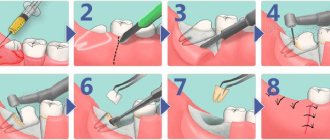During the examination, the dentist may suggest that you replace the previously installed filling with a new one. This proposal is often misunderstood:
“Doctor, this tooth doesn’t bother me, and the filling is still holding. Why change it?!”
To understand why replace an old filling with a new one, let’s figure it out: what is the function of the filling and why was it placed in the first place?
The filling restores the function of the tooth, aesthetics, protects the pulp (dental nerve) from infection, and the tooth from further destruction.
If the destruction of enamel and dentin has gone so deep that it has approached the pulp of the tooth, the “nerve” will need to be removed. “But it can be treated,” you say. Of course, the doctor will remove the tooth pulp, fill the canals and put a filling. You will learn more about canal treatment in the article Why you cannot give a 100% guarantee on tooth root canal treatment.
The problem is that after complex, lengthy and expensive root canal treatment, the tooth will become “dead” - these are not empty words. After removal of the pulp, hard tissues cease to be moistened and the walls of the tooth become fragile. Pulpitis shortens the lifespan of your tooth.
Now let's get back to replacing the old filling with a new one. The main reason for replacing an old filling with a new one is the loss of tightness of the filling of a former carious cavity. If the old filling does not prevent infection from entering the tooth, then the carious process resumes, and we already know what the consequences are.
Secondary caries develops unnoticed and cannot be detected without examination by a dentist.
In what other cases is it necessary to replace an old filling with a new one?
What are fillings and how do they appear in your mouth?
I bet you have at least one dental filling. If not, then you know exactly what it is. Teeth after damage by caries and removal of the affected areas need to be restored. Doctors most often do this by filling the resulting defect with a light-curing composite filling material. Composite fillings are a perfect color match and are quite durable, but will not last forever. As a result, a “filling” is a composite material that the doctor used to close the cavity in the tooth after removing carious tissue. The average service life of a filling is 3-5 years.
Change in tooth color (Clinical case)
Rice. 1 — A young man came to us with complaints about a change in the color of his front teeth.
Rice. 2 - We found that the old restorations were worn, discolored, and had poor marginal seal.
Selection of restoration color
Rice. 3 – Next we select the color of the restoration (composite materials).
Rice. 4 – We also evaluate composite materials with a polarized filter.
Rice. 5 - Before obtaining the silicone key, we add composite to the incisal edge to obtain the desired morphology.
Rice. 6 – Trim off excess material on the vestibular surfaces.
Rice. 7 – Apply a rubber dam.
Removing a filling
Rice. 8 – We remove old fillings with large diamond burs.
Rice. 9 – We bevel the enamel with red burs.
Rice. 10 – We remove excess material from the interdental spaces with metal strips.
Tooth preparation
Rice. 11 – Preparing the tooth for bonding. We etch the enamel.
Rice. 12 — We evaluate the etched surfaces.
Rice. 13 - Apply adhesive.
Tooth shape modeling
Rice. 14 – Let’s start modeling the tooth shape. We model the enamel layer of the palatal surface using a silicone key.
Rice. 15 — We clean the excess composite from the interdental spaces using metal strips.
Rice. 16 – Create a mesial wall using transparent tape.
Rice. 17 – Add some composite to the cutting edge.
Rice. 18 – We apply the dentin layer of the vestibular surface.
Rice. 19 - Create a groove using fissura.
Rice. 20 – Give the cutting edge a lighter shade.
Rice. 21 – Apply a thin enamel layer of composite.
Rice. 22 - Smooth the surface with a brush.
Rice. 23 - Smooth the approximal surfaces using abrasive belts.
Final processing of the restoration
Rice. 24 — Mark the boundaries.
Rice. 25 – Grind with abrasive discs.
Rice. 26 – We use glycerin for final light curing.
Rice. 27 — Creating anatomy using carbide burs.
Rice. 28 - Polishing.
Rice. 29 — Final appearance of the new restorations.
What is important in the first 2 weeks after placing a filling?
Immediately after the filling is placed, the material is not yet completely polymerized and may have micropores that are easily filled with coloring food products. This could be wine, chocolate, berries and other “bright” foods. Try not to eat such tasty things and not drink red wine for the first two weeks, but if it is simply impossible, immediately after eating, rinse your mouth with water and, if possible, brush your teeth with a toothbrush and toothpaste. After 2 weeks, a high-quality filling will no longer be stained.
Indications
Typically, patients turn to dentistry not only when necessary, but also out of personal desire. For example, if after treatment, for one reason or another, a person does not like the result. Most often this happens if the filling technology has been violated. The patient feels discomfort or is not satisfied with the aesthetics of the smile.
Other indications include:
- formation of chips and cracks in the filling material;
- loosening and partial loss of substance from the tooth cavity;
- changes in the color of tissues and shrinkage of the material, leading to a reduction in the volume and quality of the filling;
- the presence of foci of secondary caries, which are best eliminated in the initial stage;
- loose fit of the sealing substance to the edges of the treated tooth cavity.
If you notice such signs and replace the old filling in time, your own teeth will retain their whiteness for a long time and will function without the slightest disturbance. We also advise you to contact qualified specialists and give preference to high-quality raw materials. In this case, any filling will last as long as possible.
Teeth brushing, additional items and hygiene products
Naturally, your teeth need to be brushed thoroughly. And teeth with fillings need to be cleaned even more thoroughly. There are several rules for this:
- The duration of brushing your teeth should be 2-3 minutes. Not less. You don’t need more either, you can damage your tooth enamel.
- Brush your teeth with sweeping movements from the gums to the chewing surface. Clean each surface of the teeth in turn, for example, first the outer ones, then the inner ones, then the chewing ones.
- Use dental floss. This is a special thread that you can clean between teeth that are difficult to reach with a brush.
- Buy an irrigator - this device for cleaning teeth with a jet of water under pressure ideally removes plaque. In combination with proper brushing of teeth, the irrigator gives an amazing effect, eliminating problems with teeth and gums for a long time.
- Don't get carried away with whitening pastes. They always contain an abrasive substance that will scratch the surface of the fillings. These scratches will gradually fill with food pigments and the original shine will disappear.
- Use mouth rinses after brushing your teeth; they keep your mouth fresh longer and have a beneficial effect on your teeth and gums.
- Avoid rough foods; the filling is made of a composite - in other words - plastic and can easily crack or even break off with part of the tooth. Let me remind you that we are talking about rough food - crackers, chocolate-covered roasted nuts or nuts with shells.
Types of dental fillings, their cost, pros and cons
They are an alloy of metals with mercury. Yes, yes, you heard right - until recently, such fillings were installed en masse on chewing teeth. Silver amalgam contained up to 60% silver and very little mercury, and was more dangerous for the doctor during the manufacturing process than for the patient. The finished mass could not be called particularly toxic, but there was little joy from it aesthetically. And it took 3-4 hours to harden, not to mention the fact that sudden changes in cold and hot could lead to cracks in the amalgam. Even the obvious plus - excellent wear resistance - cannot cover the other disadvantages of any type of metal fillings. Currently, they are practically not installed even in public dentistry, not to mention elite clinics.
Cement fillings
A budget option when you simply don’t have enough finances for anything more. They are considered “better than nothing” and will at least cover the tooth cavity until they fall out. Permanent cement fillings should not be confused with dental cement, which is used to fix orthopedic structures and microprostheses: they use a special, especially durable material. Standard cement fillings are made from phosphate or glass ionomer cements. They are easy to knead, they are very cheap, but that’s probably where their advantages end. Even if the doctor performs the filling with exceptional care, he will not be able to achieve a perfect fit of the filling to the walls. The doctor does not have the opportunity to work with this type of material inside the tooth cavity, because... the cement sets in a matter of minutes. Over time, a gap will form between the filling and the tooth wall, where food debris and bacteria will find a home. The strength of cement fillings also leaves much to be desired; they wear out quickly. To be fair, it should be noted that glass ionomer cements have found their use in pediatric dentistry and are installed on baby teeth, but they cannot be seriously considered as full-fledged restorations in adults.
Plastic fillings
They are produced on the dental market:
- acrylic based;
- based on epoxy resins.
Acrylic fillings made of plastic have proven themselves well in aesthetic terms, because... the material has a wide color palette to choose the desired shade. Sufficient professionalism of the doctor will allow the filling to last for several years and withstand normal chewing loads. But, alas, this type also has disadvantages. Plastic is a porous material where bacteria settle, contributing to the development of dental pathologies. Acrylic fillings cannot be installed in case of deep caries, because... There is a high risk of pulpitis occurring after some time. If the patient often consumes dyes or smokes, the filling will quickly darken and lose its appearance.
Fillings based on epoxy resins have better characteristics than acrylic polymers. Toxicity still occurs, but here it is much less. Fillings of this type are more durable and safer, but they cannot be used to restore the frontal group due to the fragility of the material. And the resin-based composition darkens after just a couple of years. Thus, the object of their use remains chewing teeth.
Regular dental examinations and professional hygiene
Even the most efficient and disciplined person needs additional dental care. Self-cleaning is not enough, and once every 6 months we recommend undergoing a preventive examination and comprehensive professional oral hygiene. This procedure includes cleaning teeth from plaque using ultrasound, special AirFlow technology and subsequent polishing of teeth and fillings with a special paste. This is very useful not only for teeth, but also for fillings. This polishing removes scratches, food pigments and restores the original shine.
How does the replacement take place?
Many patients are worried: is it painful to change a filling? The procedure is performed under local anesthesia and is therefore absolutely painless.
In general terms, re-sealing occurs as follows:
- anesthesia is administered
- the desired tooth is isolated from the oral cavity with a rubber dam: so that moisture and microorganisms do not enter the treated cavity,
- old filling material and tissues affected by caries (if any) are removed
- the cavity is treated with a special etching solution and dried,
- an insulating or medicinal pad is applied,
- a new filling is applied.
Restoration takes place with mandatory consideration of the anatomical features of the chewing surface.
How long can you walk with a temporary filling?
A temporary filling can last for different periods of time, since everything depends on its composition, as well as on the specific disease:
- destruction of the nerve - up to 10 days with gentle means;
- treatment of periodontitis, elimination of inflammation - from 1 to 3 weeks, the time is calculated depending on the complexity and degree of the disease;
- Dentin augmentation or cyst treatment can take up to 3-6 months.
From this it can be seen that the filling is installed both for one day and for 6 months, so there is no single period - this issue is resolved individually. The filling still cannot last longer than six months, so you should plan your time in such a way as to be able to make it to the dentist’s visit - do not plan any long trips during the treatment period.
It is very important to have your teeth treated by a trusted specialist who can make an accurate diagnosis. Contact our clinic - we use the most modern instruments and filling compositions, and focus on the sterility and hygiene of the equipment. The doctor will check your teeth and, if necessary, place a temporary filling so that the treatment proceeds correctly and step by step.
Composition of temporary filling
The temporary filling contains safe drugs that do not harm the body. They dry very quickly, are quite flexible, and easy to work with. In this case, the compositions may be different, depending on what they are intended for:
- Dentine paste. It is elastic and sold ready-made. The paste hardens within a few minutes in the saliva.
- Glass ionomer cements are used as delayed fillings. These materials have the effect of a rechargeable battery. They accumulate fluoride from toothpastes and products and transfer them to the dental tissues, thereby providing a therapeutic anti-caries effect.
How to extend the service life of filling material
How often the filling will have to be changed depends on how correctly it is used. To extend the life of the material, just listen to the following tips:
- don’t skimp on material: very cheap means it won’t last long,
- avoid increased stress on the filling: do not open bottles, avoid excessively hard foods,
- avoid sudden changes in temperature in the oral cavity: do not take too hot or cold food,
- select oral hygiene items and products in accordance with the characteristics of the teeth.
In addition, even in the absence of complaints, you need to regularly visit the dentist for timely detection of pathologies and defects. It is better to spend a few minutes grinding than to have to refill it after some time. Preventative visits will save time and money, and will also keep your nerves and teeth in perfect order.











